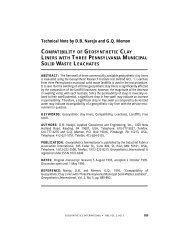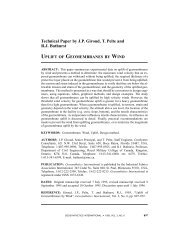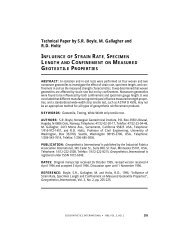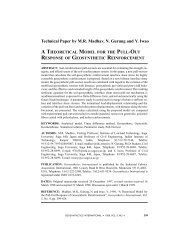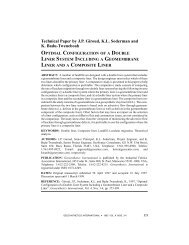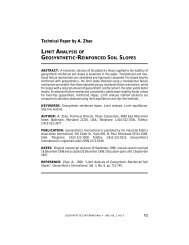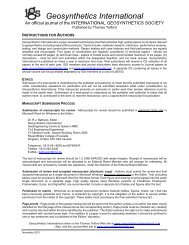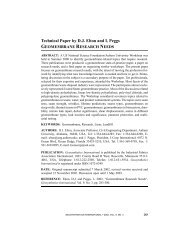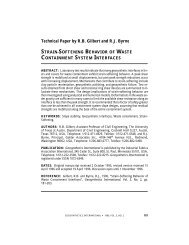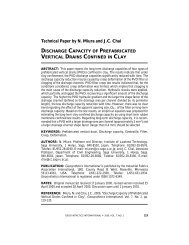leachate flow in leakage collection layers due to defects in ...
leachate flow in leakage collection layers due to defects in ...
leachate flow in leakage collection layers due to defects in ...
You also want an ePaper? Increase the reach of your titles
YUMPU automatically turns print PDFs into web optimized ePapers that Google loves.
GIROUD et al. D Leachate Flow <strong>in</strong> Leakage Collection Layers Due <strong>to</strong> Geomembrane Defects<br />
Know<strong>in</strong>g (or assum<strong>in</strong>g) the <strong>leachate</strong> head, h o , on <strong>to</strong>p of the secondary l<strong>in</strong>er vertically<br />
beneath the primary l<strong>in</strong>er defect, one may derive the virtual <strong>leachate</strong> thickness, t o ,us<strong>in</strong>g<br />
Equation 4. Then, know<strong>in</strong>g t o , t LCL and k, one may use Equation 16 <strong>to</strong> calculate the rate<br />
of <strong>leachate</strong> <strong>flow</strong> through a defect that the <strong>leakage</strong> <strong>collection</strong> layer can convey.<br />
The follow<strong>in</strong>g equation can be derived from Equation 16:<br />
t<br />
o<br />
F<br />
HG<br />
tLCL<br />
= +<br />
2<br />
Q<br />
kt<br />
1<br />
2<br />
LCL<br />
I<br />
KJ<br />
(17)<br />
The follow<strong>in</strong>g equation can be derived from Equations 13 and 16:<br />
F Q<br />
tLCL<br />
= <strong>to</strong><br />
1− 1−<br />
2<br />
kt<br />
HG<br />
o<br />
I<br />
KJ<br />
(18)<br />
Equation 18 is valid only if the follow<strong>in</strong>g condition is met:<br />
2<br />
Q ≤ k t o<br />
(19)<br />
It should be noted that if t LCL = t o , i.e. if the <strong>leakage</strong> <strong>collection</strong> layer is filled with <strong>leachate</strong><br />
at only one po<strong>in</strong>t, i.e. at the location of the primary l<strong>in</strong>er defect, Equation 16 is<br />
equivalent <strong>to</strong> Equation 9.<br />
3.3 Parametric Study<br />
Us<strong>in</strong>g the equations presented <strong>in</strong> Sections 3.1 and 3.2 it is possible <strong>to</strong> compare the<br />
<strong>flow</strong> capacity of different <strong>leakage</strong> <strong>collection</strong> <strong>layers</strong> <strong>in</strong> case of a defect <strong>in</strong> the primary<br />
l<strong>in</strong>er. In Table 1, three different <strong>leakage</strong> <strong>collection</strong> <strong>layers</strong> are compared:<br />
S a geonet with a thickness of 5 mm and a hydraulic transmissivity result<strong>in</strong>g <strong>in</strong> a hydraulic<br />
conductivity (obta<strong>in</strong>ed by divid<strong>in</strong>g the hydraulic transmissivity by the thickness)<br />
of 1 × 10 -1 m/s;<br />
S a gravel layer with a thickness of 300 mm and a hydraulic conductivity of 1 × 10 -1<br />
m/s; and<br />
S a sand layer with a thickness of 300 mm and a hydraulic conductivity of 1 × 10 -3 m/s.<br />
The first two <strong>leakage</strong> <strong>collection</strong> <strong>layers</strong> have the same hydraulic conductivity and the<br />
last two have the same thickness. In the case of the geonet, the virtual <strong>leachate</strong> thickness,<br />
t o , considered <strong>in</strong> Table 1 is greater than, or equal <strong>to</strong>, the thickness of the <strong>leachate</strong><br />
<strong>collection</strong> layer, t LCL ; therefore, <strong>in</strong> all cases considered <strong>in</strong> Table 1, the geonet is filled<br />
with <strong>leachate</strong> over a certa<strong>in</strong> area around the defect (this area be<strong>in</strong>g zero for t o = 5 mm).<br />
In the case of the gravel and sand <strong>layers</strong>, the <strong>leachate</strong> thicknesses considered <strong>in</strong> Table<br />
1 are less than, or equal <strong>to</strong>, the thickness of the <strong>leakage</strong> <strong>collection</strong> layer; therefore, <strong>in</strong><br />
all cases considered <strong>in</strong> Table 1, the gravel and sand layer are not filled (or just filled)<br />
with <strong>leachate</strong>, and for these two materials the <strong>leachate</strong> thicknesses, t o ,shown<strong>in</strong>Table<br />
1 are actual (not virtual) thicknesses.<br />
226 GEOSYNTHETICS INTERNATIONAL S 1997, VOL. 4, NOS. 3-4



